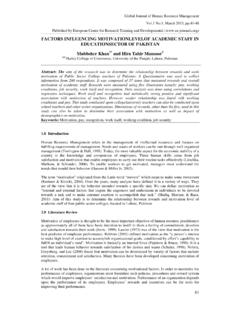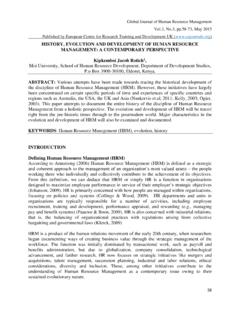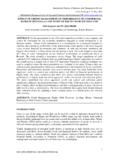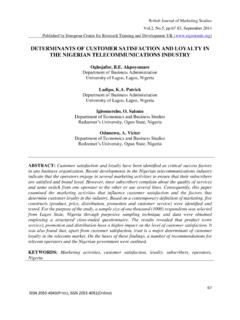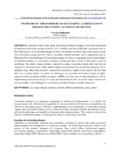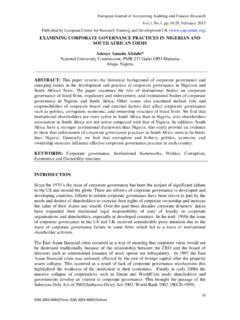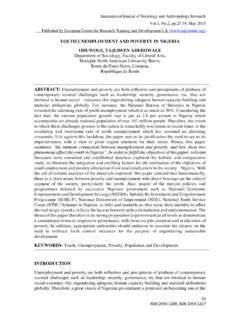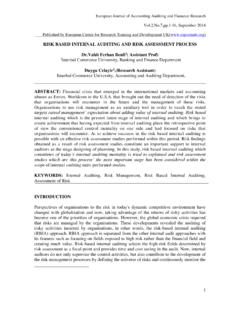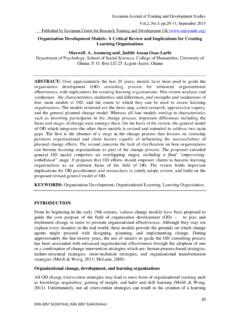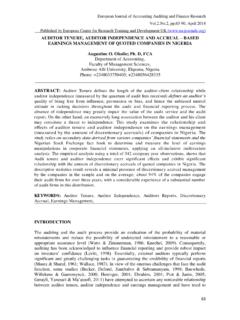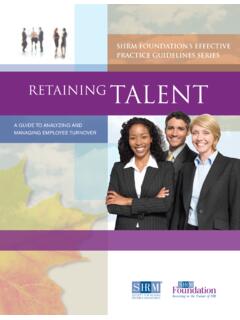Transcription of HUMAN RESOURCE THEORY: FROM HAWTHORNE …
1 Global Journal of HUMAN RESOURCE management , , , February 2016. ___Published by European Centre for Research Training and Development UK ( ). HUMAN RESOURCE theory : FROM HAWTHORNE EXPERIMENTS OF. MAYO TO GROUPTHINK OF JANIS. zg r nday PhD student, Yeditepe University Department of Business Administration. ABSTRACT: Organization is a relatively young science in comparison with the other scientific disciplines. (Ivanko, 2013) Accounts of the growth of organizational theory usually start with Taylor and Weber, but, as Scott (1987) mentions, organizations were present in the old civilizations which goes back to Sumerians (5000, BC) and which experiences its maturation phase with Taylor, Fayol and Weber, continuing to come up to present with modern management methods and principles.
2 The modern organization may be the most crucial innovation of the past 100 years and it is a theory which will never complete its evolution as the HUMAN being continues to exist. Understanding how organizations work has been the focus of scientists and scholars until the early part of the 20th century. Just as organizations have evolved, so to have the theories explaining them. These theories can be divided into 9 different schools of thought (Shafritz, Ott, Jang, 2005): Classical Organization theory , Neoclassical Organization theory , HUMAN RESOURCE theory , or the Organizational Behavior Perspective, Modern Structural Organization theory , Organizational Economics theory , Power and Politics Organization theory , Organizational Culture theory , Reform Though Changes in Organizational Culture and Theories of Organizations and Environments.
3 This introductory paper will concentrate on the HUMAN relations theory and is divided as follows. The introduction talks about the developments of the organization and organization theory from its early stages with detailed definitions. In section 2, theoretical roots in other words literature review on the subject will be presented. At further section, by looking at the perspectives of the 5 pioneering people (Mayo, Follett, Maslow, McGregor and Janis,) main principles of the classical organization theory are presented one by one. Section 4 mentions strengths and weaknesses of the classical organizational theory and section 5 discusses and concludes the paper.
4 KEYWORDS: HUMAN RESOURCE , Organization, Organization theory . INTRODUCTION. Organization theory is not an easy concept. Unless you are naturally interested to the abstract, you probably expect this subject to be dry, unconnected to practical matters and perhaps a little boring. Even if you are inerested about abstractions, it can be borin to confront as many of them at one time as organization theory asks you to do. So why would anyone sign up to study this complex and difficult subject matter? There are various answers to this question. For some, studying organization theory is motivated by curiosity.
5 They want to know what it would be like to think like an organization, to get inside organizing processes far enough to reveal the intricate organizational patterns that make organizations understandable. Others are motivated by the attraction of stretching their minds in new ways. For example, organization theory relies on the sciences, the humanities and the arts, and so presents the intellectual challenge of thinking in interdisciplinary ways. Some turn 95. ISSN 2053-5686(Print), ISSN 2053-5694(Online). Global Journal of HUMAN RESOURCE management , , , February 2016. ___Published by European Centre for Research Training and Development UK ( ).
6 To organization theory in the hope that it will get better their chances of becoming successful executives in business, government or non-profit organizations. Table lists some of their specific reasons. Man is intent on describing himself into a web of collectivized patterns. ``Modern man has learned to accommodate himself to a world increasingly organized. The trend toward ever more explicit and consciously drawn relationships is profound and sweeping; it is marked by depth no less than by extension.`` This comment by Seidenberg summarizes the influence of organization in many shapes of HUMAN activity.
7 Some of the reasons for hectic organizational activity are found in the main transitions which revolutionized our society, shifting it from a rural culture, to a culture based on technology, industry, and the city. From these shifts, a way of life occurred and characterized by the proximity and dependency of people on each other. Proximity and dependency, as conditions of social life, harbor the threats of HUMAN conflict, capricious antisocial behavior, instability of HUMAN relationships, and uncertainty about the nature of the social structure with its concomitant roles. Of course, these threats to social integrity are still exist to some degree in all societies, ranging from the primitive to the modern.
8 But, these threats become serious when the harmonious functioning of a society acts upon the maintenance of a highly intricate, delicately balanced shape of HUMAN collaboration. The civilization we have generated depends on the preservation of a precarious balance. Hence, disrupting forces impinging on this shaky form of collaboration must be prohibited or minimized. 96. ISSN 2053-5686(Print), ISSN 2053-5694(Online). Global Journal of HUMAN RESOURCE management , , , February 2016. ___Published by European Centre for Research Training and Development UK ( ). Traditionally organization is seen as a intermediary for accomplishing goals and objectives.
9 While this approach is nifty, it tends to obscure the inner workings and internal aims of organization itself. Another fruitful way of behaving organization is as a mechanism having the ultimate aim of offsetting those forces which undermine HUMAN collaboration. In this approach, organization sloping towards to minimize conflict, and to lessen the meaning of individual behavior which deviates from values that the organization has established as worthwhile. Further, organization increases stability in HUMAN relationships by decreasing uncertainty regarding the nature of the system's structure and the HUMAN roles which are inherent to it.
10 Parallel to this point, organization enhances the predictability of HUMAN action, because it limits the number of behavioral alternatives available to an individual. (Scott, 1961). Furthermore, organization has built-in safeguards. Besides prescribing acceptable shapes of behavior for those who elect to submit to it, organization is also capable to counterbalance the effects of HUMAN action which transcends its established ways. Few segments of society have engaged in organizing more strongly than business. The reason is clear. Business depends on what organization offers. Business requires a system of relationships among functions' it requires stability, continuity, and predictability in its internal activities and external contacts.
